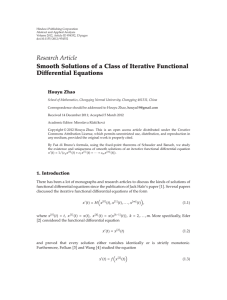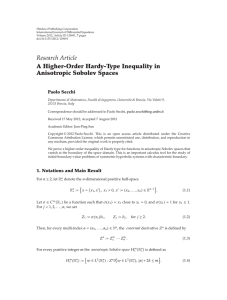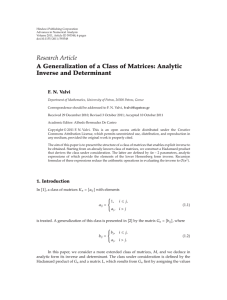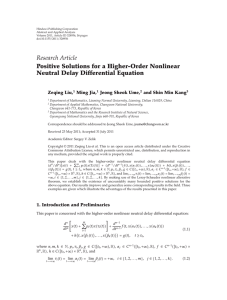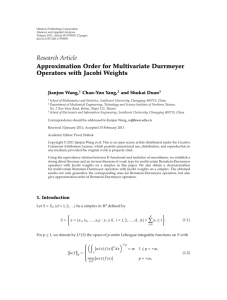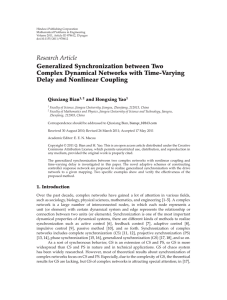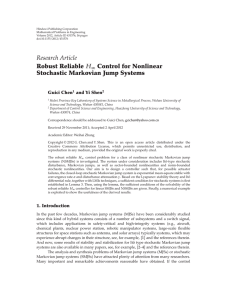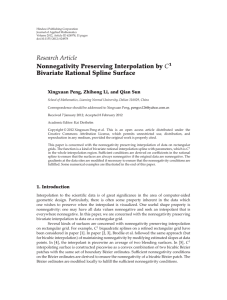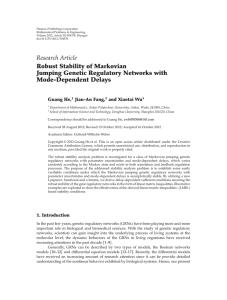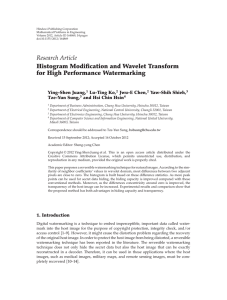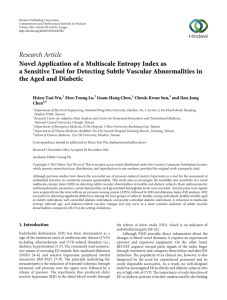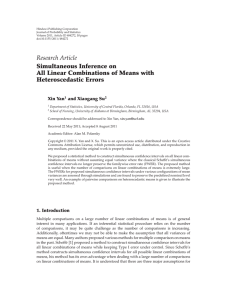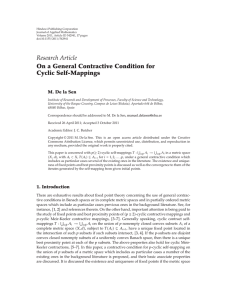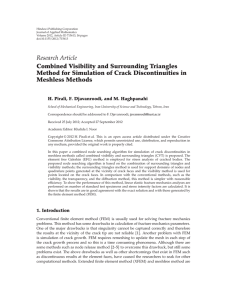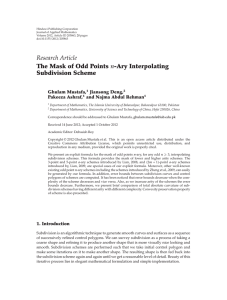Document 10857658
advertisement
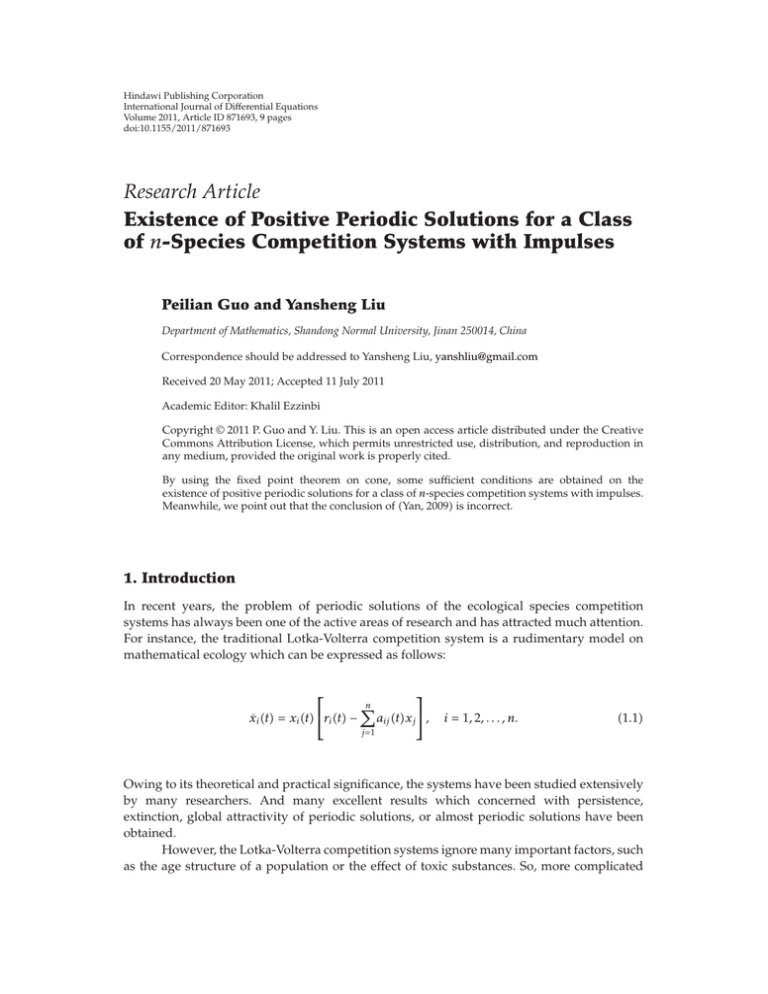
Hindawi Publishing Corporation
International Journal of Differential Equations
Volume 2011, Article ID 871693, 9 pages
doi:10.1155/2011/871693
Research Article
Existence of Positive Periodic Solutions for a Class
of n-Species Competition Systems with Impulses
Peilian Guo and Yansheng Liu
Department of Mathematics, Shandong Normal University, Jinan 250014, China
Correspondence should be addressed to Yansheng Liu, yanshliu@gmail.com
Received 20 May 2011; Accepted 11 July 2011
Academic Editor: Khalil Ezzinbi
Copyright q 2011 P. Guo and Y. Liu. This is an open access article distributed under the Creative
Commons Attribution License, which permits unrestricted use, distribution, and reproduction in
any medium, provided the original work is properly cited.
By using the fixed point theorem on cone, some sufficient conditions are obtained on the
existence of positive periodic solutions for a class of n-species competition systems with impulses.
Meanwhile, we point out that the conclusion of Yan, 2009 is incorrect.
1. Introduction
In recent years, the problem of periodic solutions of the ecological species competition
systems has always been one of the active areas of research and has attracted much attention.
For instance, the traditional Lotka-Volterra competition system is a rudimentary model on
mathematical ecology which can be expressed as follows:
⎡
⎤
n
ẋi t xi t⎣ri t − aij txj ⎦,
i 1, 2, . . . , n.
1.1
j1
Owing to its theoretical and practical significance, the systems have been studied extensively
by many researchers. And many excellent results which concerned with persistence,
extinction, global attractivity of periodic solutions, or almost periodic solutions have been
obtained.
However, the Lotka-Volterra competition systems ignore many important factors, such
as the age structure of a population or the effect of toxic substances. So, more complicated
2
International Journal of Differential Equations
competition systems are needed. In 1973, Ayala and Gilpin proposed several competition
systems. One of the systems is the following competition system:
⎡
Ṅi t ri Ni ⎣1 −
Ni
Ki
θi
⎤
Nj
⎦,
−
αij
K
j
j1,j i
/
n
i 1, 2, . . . , n,
1.2
where Ni is the population density of the ith species; ri is the intrinsic exponential growth
rate of the ith species; Ki is the environmental carrying capacity of species i in the absence
of competition; θij provides a nonlinear measure of interspecific interference, αij provides a
nonlinear measure of interspecific interference.
On the other hand, in the study of species competition systems, the effect of some
impulsive factors has been neglected, which exists widely in the real world. For example,
the harvesting or stocking occur at fixed time, natural disaster such as fire or flood happen
unexpectedly, and some species usually migrate seasonally. Consequently, such processes
experience short-time rapid change which can be described by impulses. Therefore, it is
important to study the existence of the periodic solutions of competitive systems with
impulse perturbation see 1–7 and the references therein.
For example, by using the method of coincidence degree, Wang 1 considered
the existence of periodic solutions for the following n-species Gilpin-Ayala impulsive
competition system:
⎡
ẋi t xi t⎣ri t −
n
j1
αij
aij txj t
⎤
n
n
αij αij
αii
− bij txj t − τij t − cij txi txj t⎦,
j1
t
/ tk ;
j1
Δxi tk xi t
k − xi t−k pki xi tk ,
k 1, 2, 3, . . . ,
1.3
where the constant pki satisfied −1 < pki < 0, i 1, 2, . . . , n. What is more, 1 also obtained
several results for the persistence and global attractivity of the periodic solution of the model.
In 2, Yan applied the Krasnoselskii fixed point theorem to investigate the following
n-species competition system:
⎡
ẏi t yi t⎣ri t −
n
j1
−
n
j1
αij
aij tyj t −
cij t
0
−σij
n
βij bij tyj t − τij t
j1
1.4
⎤
γij
δij
Kij ξyi t ξyj t ξdξ⎦,
i 1, 2, . . . , n,
where the constants αij , βij , γij ≥ 1, i, j 1, 2, . . . , n. He obtained a necessary and sufficient
condition for the existence of periodic solutions of system 1.4. Unfortunately, its last
conclusion is wrong. Please see the remark in Section 3 of this paper.
International Journal of Differential Equations
3
Motivated by 1, 2, in this paper, we investigate the following impulsive n-species
competition system:
⎡
ẏi t yi t⎣ri t −
n
n
αij
βij aij tyj t − bij tyj t − τij t
j1
−
n
j1
cij t
j1
0
−σij
⎤
γij
δij
Kij ξyi t ξyj t ξdξ⎦,
Δyi tk yi t
k − yi t−k Iik y1 tk , y2 tk , . . . , yn tk ,
t/
tk , i 1, 2, . . . , n,
k 1, 2, . . . , m,
1.5
where yi t is the population density of the ith species at time t; ri t is the intrinsic
exponential growth rate of the ith species at time t; τij t is the time delay; σij is a positive
j measure the amount of competition between the species
constant; aij t, bij t, cij t i /
j provide a nonlinear measure of interspecific interference; yi t
k Yi and Yj ; αij , βij , δij i /
yi t−k is the left right limits of yi t at t tk , i, j 1, 2, . . . , n, k 1, 2, . . . , m.
The main features of the present paper are as follows. The Gilpin-Ayala species
competition system 1.5 has impulsive effects. As is known to us, there were few papers
to study such system. Finally, we point out that the conclusion of 2
ω is incorrect.
For an ω-periodic function ut ∈ CR, R, let u 1/ω 0 utdt. Throughout this
paper, assume the following conditions hold.
H1 ri , aij , bij , cij , τij are continuous ω-periodic functions, and r i > 0, aij t,
bij t, cij t ≥ 0, i, j 1, 2, . . . , n, and there exists i0 1 ≤ i0 ≤ n such that
min1≤j≤n ai0 j bi0 j > 0.
0
H2 Kij ∈ C−σij , 0, R, Kij ≥ 0, σij is a positive constant, and −σij Kij tdt 1, i, j 1, 2, . . . , n.
H3 Iik ∈ CRn , 0, ∞, and for 0 < t1 < t2 < · · · < tm < ω, there exists an positive
integer l > 0 such that tk
lm tk lω, Iik y1 , y2 , . . . , yn Iik
lm y1 , y2 , . . . , yn ,
where y1 , y2 , . . . , yn ∈ Rn , i 1, 2, . . . , n, k 1, 2, . . . , m.
H4 αij , βij , δij > 0, γij ≥ 0 are constants, i, j 1, 2, . . . , n.
In order to prove our main result, now we state the fixed point theorem of cone
expansion and compression.
Lemma 1.1 see 4. Let E be a Banach space, and let P be a cone in E. Assume that Ω1 , Ω2 are
open subsets of E with 0 ∈ Ω1 , Ω1 ⊆ Ω2 . Let A : P ∩ Ω2 \ Ω1 → P be a completely continuous
operator such that one of the following two conditions is satisfied:
i Ax
for x ∈ P ∩ ∂Ω2 ,
for x ∈ P ∩ ∂Ω1 ; Ax
;
Ax
ii Ax
for
x
∈
P
∩
∂Ω
for x ∈ P ∩ ∂Ω1 ,
2
Then, A has a fixed point in P ∩ Ω2 \ Ω1 .
The organization of this paper is as follows. In the next section, we introduce some
lemmas and notations. In Section 3, the main result will be stated and proved on the existence
of periodic solutions of system 1.5.
4
International Journal of Differential Equations
2. Preliminaries
Let P CR, Rn {yt y1 t, y2 t, · · · yn t : R → Rn | yi t be continuous at t / tk ,
left continuous at t tk , and the right limit yi tk exists for i 1, 2, . . . , n, k 1, 2, . . . , m}.
Evidently,
E yt y1 t, y2 t, . . . yn t ∈ P CR, Rn | yi t yi t ω, i 1, 2, . . . , n
2.1
is a Banach space with the norm y ni1 |yi |0 , where |yi |0 maxt∈0,ω |yi t|.
Define an operator T : E → E by T yt T y1 t, T y1 t, . . . , T yn t, where
T y i t t
ω
t
⎡
n
n
αij
βij Gi t, syi s⎣ aij syj s bij syj s − τij s
j1
j1
0
n
cij s
−σij
j1
⎤
γij
Kij ξyi s
δij
ξyj s
ξdξ⎦ds
2.2
m
Gi t, tk
qk m Iik y1 tk , y2 tk , . . . , yn tk ,
k1
s
where Gi t, s exp− t ri νdν/1 − exp−ωr i , t ≤ s ≤ t ω, i 1, 2, . . . , n, and tk
qk m tk qk ω ∈ t, t ω, where qk is a positive integer, k 1, 2, . . . , m.
It is obvious that the functions Gi t, s, i 1, 2, . . . , n have the following properties.
i Gi t, s > 0 for t, s ∈ R2 , and Gi t, s Gi t ω, s ω.
ii A ≤ Gi t, s ≤ B for t, s ∈ R2 , where A min1≤i≤n {exp−ωr i /1 − exp−ωr i },
B min1≤i≤n {expωr i /1 − exp−ωr i }.
Now, we choose a set defined by
P yt y1 t, y2 t, . . . yn t ∈ E | yi t ≥ σ yi 0 , t ∈ 0, ω, i 1, 2, . . . , n ,
2.3
where σ A/B. Clearly, P is a cone in E.
For the sake of convenience, we define an operator F : P → E by Fyt Fy1 t, Fy2 t, . . . , Fyn t, where
⎡
n
n
αij
βij Fy i t yi t⎣ aij tyj t bij tyj t − τij t
j1
j1
n
cij t
j1
0
−σij
2.4
⎤
γij
δij
Kij ξyi t ξyj t ξdξ⎦,
Lemma 2.1. The operator T : P → P is completely continuous.
i 1, 2, . . . , n.
International Journal of Differential Equations
5
Proof. First, it is easy to see T : P CR, Rn → P CR, Rn . Next, since
T y i t ω
t
2ω
t
ω
t
ω
t
t
ω
t
m
Gi t ω, s Fy i sds Gi t ω, tk
qk m ω Iik y1 tk , y2 tk , . . . , yn tk k1
m
Gi t ω, υ ω Fy i υ ωdυ Gi t, tk
qk m Iik y1 tk , y2 tk , . . . , yn tk k1
m
Gi t, υ Fy i υdυ Gi t, tk
qk m Iik y1 tk , y2 tk , . . . , yn tk k1
T y i t,
2.5
we have T y ∈ E.
Observe that A ≤ Gi t, s ≤ B, i 1, 2, . . . , n, for all s ∈ t, t ω. Hence, we obtain that,
for y ∈ P ,
Ty ≤ B
i 0
T y i t ≥ A
ω
0
ω
0
m
Fy i sds B Iik y1 tk , y2 tk , . . . , yn tk ,
k1
m
A Fy i sds A Iik y1 tk , y2 tk , . . . , yn tk ≥ T y i 0 σ T y i 0 .
B
k1
2.6
Thus, T y ∈ P , that is, T P ⊂ P .
Obviously, the operator T is continuous. Next, we show that T is compact. Let S ⊂ E
be a bounded subset; that is, there exists d > 0 such that |yi |0 ≤ d, i 1, 2, . . . , n for all y ∈ S.
From the continuity of F, Ik , k 1, 2, . . . , m, we have, for all y ∈ S,
Ty ≤ B
i 0
ω
0
≤ Bωd
m
Fy i sds B Iik y1 tk , y2 tk , . . . , yn tk k1
n 2.7
aij dαij bij dβij cij dγij δij BmEi : Di ,
j1
where Ei maxy∈S |Iik y1 tk , y2 tk , . . . , yn tk |, i 1, 2, . . . , n.
Therefore, T y ni1 |T yi |0 ≤ ni1 Di : D, which implies that T S is uniformly
bounded.
6
International Journal of Differential Equations
On the other hand, noticing that
d T y i t ri t T y i t Gi t, t ω Fy i t ω − Gi t, t Fy i t
dt
ri t T y i t Gi t, t ω − Gi t, t Fy i t
ri t T y i t Fy i t,
2.8
t
/ tk , k 1, 2, . . . , m.
This guarantees that, for each y ∈ S, we have
n n
d M αij
M βij
M γij δij
≤ r M Di d
i ≤ D
i ,
a
:
D
d
b
d
c
d
D
T
y
t
i
ij
ij
ij
dt
i
j1
i1
2.9
M
M
where riM maxt∈0,ω ri t, aM
ij maxt∈0,ω aij t, bij maxt∈0,ω bij t, cij maxt∈0,ω cij t,
i 1, 2, . . . , n.
Consequently, T S is equicontinuous on Jk , k 0, 1, 2, . . . , m, where J0 0, t1 , J1 t1 , t2 , . . . , Jm−1 tm−1 , tm , Jm tm , ω. By the Ascoli-Arzela theorem, the function T : P →
P is completely continuous from P to P .
Lemma 2.2. The system 1.5 has a positive ω-periodic solution in P if and only if T has a fixed point
in P .
Proof. For y ∈ P satisfying T y y, that is, T yi t yi t, t ∈ 0, ω, i 1, 2, . . . , n, it follows
from 2.2 and 2.4 that
ẏi t d T y i t
dt
ri t T y i t Gi t, t ω Fy i t ω − Gt, t Fy i t
2.10
ri t T y i t Gt, t ω − Gt, t Fy i t
ri t T y i t Fy i t,
t/
tk , k 1, 2, . . . , m.
And for t tk , k 1, 2, . . . , m,
Δyi tk yi t
k − yi t−k Iik y1 tk , y2 tk , . . . , yn tk ,
which implies that yt is a positive ω-periodic solution of 1.5.
i 1, 2, . . . , n,
2.11
International Journal of Differential Equations
7
Conversely, assume that y ∈ P is an ω-periodic solution of system 1.5. Then, the
system 1.5 can be transformed into
t
t
ẏi t rtyi t e 0 rνdν Fy i te 0 rνdν ,
2.12
that is,
t
yi te 0 rνdν
t
Fy i te 0 rνdν .
2.13
So, integrating the above equality from t to t ω and noticing that yi t yi t ω, we
have
T y i t t
ω
t
⎡
n
n
αij
βij Gi t, syi s⎣ aij syj s bij syj s − τij s
j1
j1
n
cij s
j1
0
−σij
⎤
γij
δij
Kij ξyi s ξyj s ξdξ⎦ds
2.14
m
Gi t, tk
qk m Iik y1 tk , y2 tk , . . . , yn tk ,
k1
s
where Gi t, s exp− t ri νdν/1 − exp−ωr i , t ≤ s ≤ t ω, i 1, 2, . . . , n, and tk
qk m tk qk ω ∈ t, t ω, where qk is a positive integer, k 1, 2, . . . , m, that is, T y y.
Therefore, y ∈ P is a fixed point of the operator T . The proof of the Lemma is complete.
3. Main Results
Theorem 3.1. Suppose (H1)–(H4) hold, and lim|v| → 0 Iik v/|v| 0, k 1, 2, . . . , m, i 1, 2, . . . , n, where v v1 , v2 , . . . , vn , |v| min1≤i≤n |vi |. Then system 1.5 has at least one positive
ω-periodic solution.
Proof. Let M0 max1≤i≤n { nj1 aij bij cij } > 0. Choose M1 ≥ M0 and ε 1/BωM1 Bm >
0. Then, there exists δ > 0 such that, for 0 < x < δ and 0 < |v| < δ, we have
xαij < ε,
Iik v < ε|v|,
xβij < ε,
xγij δij < ε,
k 1, 2, . . . , m, i, j 1, 2, . . . , n.
3.1
Choose r < δ. Let Ω1 {yt y1 t, y2 t, . . . , yn t ∈ E | |yi |0 < r, i 1, 2, . . . , n}.
Now, we prove that
T y
y,
∀y ∈ P ∩ ∂Ω1 .
3.2
8
International Journal of Differential Equations
Suppose 3.2 does not hold. Then, there exists some y ∈ P ∩ ∂Ω1 such that T y ≥ y.
Since y ∈ P ∩ ∂Ω1 , we have σ|yi |0 ≤ yi t ≤ |yi |0 for t ∈ 0, ω, i 1, 2, . . . , n. From 2.2 and
2.4, it follows that
T yi t ≤ B
t
ω
m
Fy i sds B Iik y1 tk , y2 tk , . . . , yn tk t
k1
≤ Bωyi n
αij
βij
γij δij
Bmεyi 0
aij r bij r cij r
0
3.3
i1
≤ BM0 ωε Bmεyi 0 < yi 0 ,
which implies |T yi |0 < |yi |0 , a contradiction. Hence, T y
y for y ∈ P ∩ ∂Ω1 .
On the other hand, let m0 min1≤j≤n {ai0 j σ αij bi0 j σ βij }, on the account of H1, we
know m0 > 0. Choose 0 < m1 ≤ m0 and M 1/Aσωm1 > 0. Then, there exists R1 > 0 such
that, for x > R1 , we know that
xαij > M,
xβij > M,
i, j 1, 2, . . . , n.
3.4
Choose R > max{R1 , r}. Let Ω2 {yt y1 t, y2 t, . . . yn t ∈ E | |yi |0 < R, i 1, 2, . . . , n}. Then, ∂Ω2 {yt y1 t, y2 t, . . . yn t ∈ E | there exist some integers j0 1 ≤
j0 }.
j0 ≤ n such that |yj0 |0 R;|yi |0 ≤ R for i /
Next we show that
Ty
y,
∀y ∈ P ∩ ∂Ω2 .
3.5
In fact, if there exists some y ∈ P ∩∂Ω2 such that T y ≤ y and since y ∈ P ∩∂Ω2 , we have
σ|yi |0 ≤ yi t ≤ |yi |0 , i 1, 2, . . . , n for t ∈ 0, ω, and there exists some j0 such that |yj0 |0 R.
Therefore, this together with H1 guarantees that, for i0 1 ≤ i0 ≤ n,
yi0 t ≥ T y i0 t ≥ A
≥ Aσ yi0 0
≥ Aσ yi0 0
t
ω
Fy
t
i0 sds
t
ω t
αi j
βi j
ai0 j0 syj0 0 0 s bi0 j0 syj0 0 0 s − τs ds
t
ω t
αi j
β i j ai0 j0 sσ αi0 j0 yj0 0 0 0 bi0 j0 sσ βi0 j0 yj0 0 0 0 ds
≥ Aσ yi0 0 ωM ai0 j0 σ αi0 j0 bi0 j0 σ βi0 j0
≥ AσωMm0 yi0 0 > yi0 0 ,
which is a contradiction. Thus, 3.5 is satisfied.
3.6
International Journal of Differential Equations
9
From all the above, the condition i of Lemma 1.1 is satisfied. So the operator T has a
fixed point in P ∩Ω2 \Ω1 . That is, system 1.5 has at least one positive periodic solution.
Remark 3.2. For any R > 0, if we let Ω {yt y1 t, y2 t, . . . , yn t ∈ E | |yi |0 < R, i 1, 2, . . . , n}, then ∂Ω {yt y1 t, y2 t, . . . , yn t ∈ E | ∃ j0 1 ≤ j0 ≤ n, |yj0 |0 R, |yi |0 ≤
R, i /
j0 }. However, in the proof of Theorem 1.1 of 2, it is regarded mistakenly as ∂Ω {yt y1 t, y2 t, . . . , yn t ∈ E | |yi |0 R, i 1, 2, . . . , n}. Therefore, the proof of its
sufficiency is not correct. So the result of 2 is incorrect.
Acknowledgments
This research was supported by the Natural Science Foundation of Shandong Province
ZR2009AM006, the Key Project of Chinese Ministry of Education no. 209072, and the
Science and Technology Development Funds of Shandong Education Committee J08LI10.
References
1 Q. Wang, M. Ding, Z. Wang, and H. Zhang, “Existence and attractivity of a periodic solution for an Nspecies Gilpin-Ayala impulsive competition system,” Nonlinear Analysis, Real World Applications, vol.
11, no. 4, pp. 2675–2685, 2010.
2 J. Yan, “Global positive periodic solutions of periodic n-species competition systems,” Journal of
Mathematical Analysis and Applications, vol. 356, no. 1, pp. 288–294, 2009.
3 L. Chen and L. Chen, “Positive periodic solution of a nonlinear integro-differential prey-competition
impulsive model with infinite delays,” Nonlinear Analysis, Real World Applications, vol. 11, no. 4, pp.
2273–2279, 2010.
4 J. Yan and G. Liu, “Periodicity and stability for a Lotka-Volterra type competition system with feedback
controls and deviating arguments,” Nonlinear Analysis: Theory, Methods and Applications, vol. 74, pp.
2916–2928, 2011.
5 Y. Liu and K. Lu, “Permanence and periodic solution of an impulsive delay two-prey one-predator
system with variable coefficients,” Chinese Quarterly Journal of Mathematics, vol. 24, no. 2, pp. 267–273,
2009.
6 S. Yu, W. Xiong, and H. Qi, “A ratio-dependent one-predator two-competing-prey model with delays
and refuges,” Mathematica Applicata, vol. 23, no. 1, pp. 198–203, 2010.
7 W. X. Xu, T. L. Zhang, and Z. B. Xu, “Existence of positive periodic solutions of a prey-predator system
with several delays,” Acta Mathematica Scientia, vol. 28, no. 1, pp. 39–45, 2008.
Advances in
Operations Research
Hindawi Publishing Corporation
http://www.hindawi.com
Volume 2014
Advances in
Decision Sciences
Hindawi Publishing Corporation
http://www.hindawi.com
Volume 2014
Mathematical Problems
in Engineering
Hindawi Publishing Corporation
http://www.hindawi.com
Volume 2014
Journal of
Algebra
Hindawi Publishing Corporation
http://www.hindawi.com
Probability and Statistics
Volume 2014
The Scientific
World Journal
Hindawi Publishing Corporation
http://www.hindawi.com
Hindawi Publishing Corporation
http://www.hindawi.com
Volume 2014
International Journal of
Differential Equations
Hindawi Publishing Corporation
http://www.hindawi.com
Volume 2014
Volume 2014
Submit your manuscripts at
http://www.hindawi.com
International Journal of
Advances in
Combinatorics
Hindawi Publishing Corporation
http://www.hindawi.com
Mathematical Physics
Hindawi Publishing Corporation
http://www.hindawi.com
Volume 2014
Journal of
Complex Analysis
Hindawi Publishing Corporation
http://www.hindawi.com
Volume 2014
International
Journal of
Mathematics and
Mathematical
Sciences
Journal of
Hindawi Publishing Corporation
http://www.hindawi.com
Stochastic Analysis
Abstract and
Applied Analysis
Hindawi Publishing Corporation
http://www.hindawi.com
Hindawi Publishing Corporation
http://www.hindawi.com
International Journal of
Mathematics
Volume 2014
Volume 2014
Discrete Dynamics in
Nature and Society
Volume 2014
Volume 2014
Journal of
Journal of
Discrete Mathematics
Journal of
Volume 2014
Hindawi Publishing Corporation
http://www.hindawi.com
Applied Mathematics
Journal of
Function Spaces
Hindawi Publishing Corporation
http://www.hindawi.com
Volume 2014
Hindawi Publishing Corporation
http://www.hindawi.com
Volume 2014
Hindawi Publishing Corporation
http://www.hindawi.com
Volume 2014
Optimization
Hindawi Publishing Corporation
http://www.hindawi.com
Volume 2014
Hindawi Publishing Corporation
http://www.hindawi.com
Volume 2014

